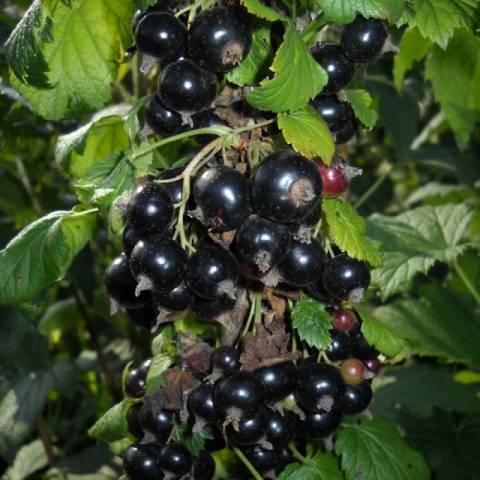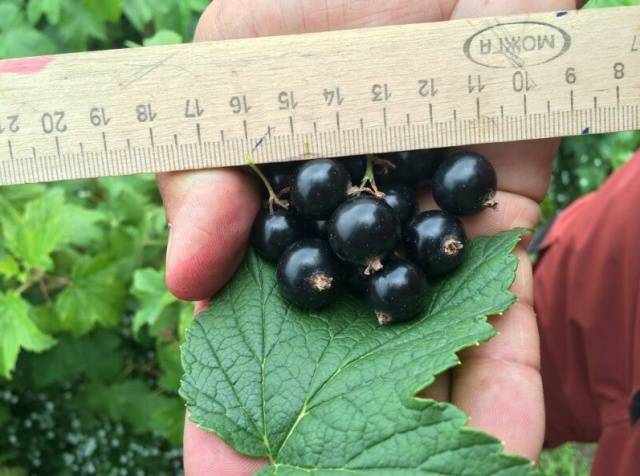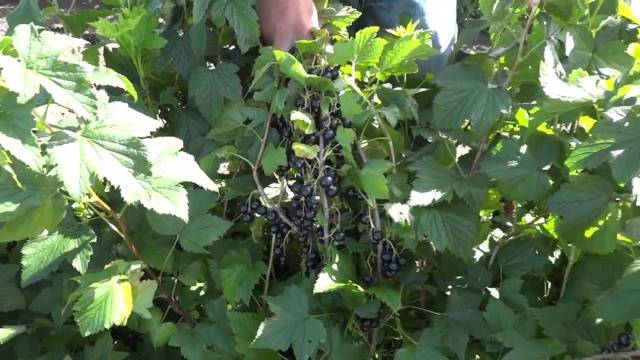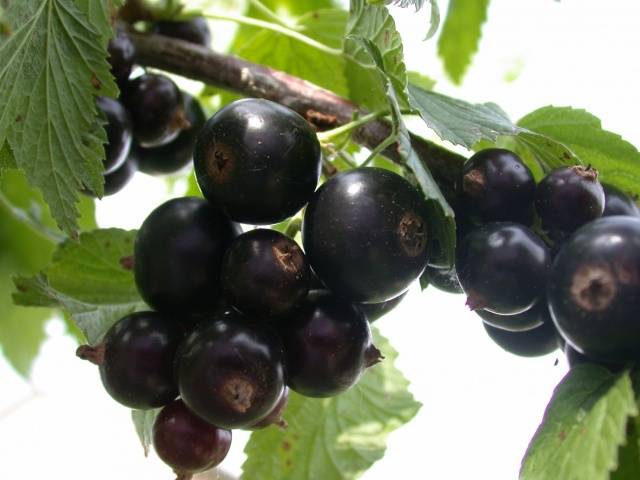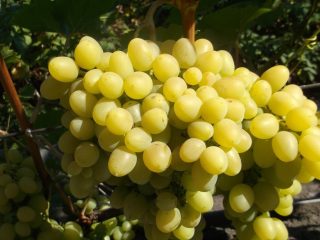Content
Black currant Nara is a variety of Russian selection, adapted to the conditions of the middle lane. The ripening of the crop occurs at an early date, the berries are of universal use. Nara currant tolerates drought, winter frosts, and is not susceptible to diseases.
Characteristics of the variety
Nara currant was bred by breeders of the Bryansk region. Since 1999, the Nara variety has been present in the state register and is recommended for cultivation in the Central Region.
Description of the variety of black currant Nara:
- earlier fruiting;
- flowering in early May;
- medium-sized bush;
- bush height up to 1.5 m;
- slightly spreading shoots;
- branches of medium size, slightly curved;
- large wrinkled leaves;
- convex leaf plate.
Description of Nara currant berries:
- weight from 1.3 to 3.4 g;
- black color;
- rounded shape;
- greenish pulp;
- sweet and sour taste;
- taste assessment - 4.3 points.
Nara currant ripens in early June. In cold regions, flowers are susceptible to spring frosts.
The Nara variety has a high yield. 10-14 kg of fruits are harvested from the bush. The berries ripen at the same time. The fruits are rich in vitamin C, the content of which is 179 mg.
The currant of the Nara variety has a universal purpose. Berries are frozen or consumed immediately after collection, subjected to any kind of processing.
Planting currants
The lifespan of black currants is 15-20 years. The site for planting must meet a number of requirements, which include illumination, lack of wind, soil fertility. To grow a powerful and healthy bush, strong seedlings are chosen.
Site selection
Blackcurrant Nara prefers sunny areas. When grown in the shade, yield decreases and the berries acquire a sour taste. It is allowed to plant bushes from the south or southwest side of the fence or building.
The shrub is planted in loose, fertile soil. The ideal option for planting is loam. In clay soil, the bushes grow slowly and bear few berries. Currants do not like acidified soils, so they must be limed before planting.
Currants are a moisture-loving crop, but wetlands and constant exposure to moisture lead to root rot. In order for the soil to pass moisture better, you can add several buckets of coarse river sand when planting.
Breeding varieties
Seedlings of the Nara variety are purchased from trusted suppliers. It is better to choose a nursery to ensure you get quality planting material.
Healthy seedlings have woody roots up to 20 cm long. The optimal shoot length is 30 cm, the number of buds is from 3 to 6 pcs. The seedlings should not show signs of damage, growths, cracks, spots.
If the Nara currant has already been planted on the site, then you can get the planting material yourself.
Breeding methods for black currant Nara:
- Layers. In the spring, the strongest shoots are chosen. They are bent to the ground and lowered into prepared furrows. Shoots are fastened with staples and covered with soil. In the summer, the layers are watered, and in the fall they are separated from the main plant and transplanted.
- Cuttings. In summer, annual basal shoots are separated from the main bush. It is best to choose branches 10 mm thick and 20 mm long. Cuttings are placed in boxes filled with wet sand.By the fall, the seedlings will take root, and they are transferred to a permanent place.
- By dividing the bush. If it is necessary to transplant currants, its rhizome can be divided into parts and planting material can be obtained. Places of cuts are sprinkled with wood ash. Several healthy roots are left for each bush.
Landing order
Black currant Nara is planted in autumn after leaf fall or in spring, when the snow melts and the soil warms up. It is best to complete the work in the fall, then the bush will have time to take root before winter.
The sequence of actions for planting black currant:
- Work begins with the preparation of a pit 50 cm in size and 40 cm deep.
- A substrate is placed at the bottom, consisting of 2 buckets of humus, 3 liters of wood ash and 70 g of superphosphate.
- After the nutrient layer, fertile soil is poured.
- The pit is left for 3 weeks for the earth to settle.
- Dry or damaged roots are cut off from the seedling, all the leaves are cut off.
- The plant is placed in a hole, the root collar is buried 7 cm.
- The roots of the seedling are covered with earth and water is plentiful.
- Shoots are cut off, 10-15 cm are left above the surface.
After planting, the Nara currant is watered weekly. The soil is mulched with humus or straw. For the winter, the shoots are huddled, dry leaves are poured on top.
Variety care
Fruiting of Nara currants largely depends on care. Bushes need watering and feeding. In the fall, currants are pruned to get a bountiful harvest for the next year. Preventive measures help protect shrubs from diseases and pests.
Watering
Black currants require regular watering. The Nara variety is capable of withstanding short-term drought. With a lack of moisture, the ovaries fall off, the berries become smaller, the development of the entire bush slows down.
Increased attention is paid to watering at certain stages of the development of the bush:
- during the flowering period;
- with the formation of ovaries;
- while pouring berries.
3 buckets of water are poured under each bush. The moisture must first settle and heat up in barrels. In dry summers, the bushes are watered 1-2 times a week.
After watering, the soil is loosened to improve the penetration of moisture to the roots. Be sure to weed weeds.
Top dressing
If fertilizers were used when planting Nara currants, then regular feeding begins only for 3 years. For processing, solutions are prepared from natural or mineral substances.
In the spring, the bushes are fed with slurry or a solution consisting of 30 g of urea per 5 liters of water. Nitrogen stimulates the formation of new shoots and leaves. Its use is limited during flowering and berry appearance.
The complex fertilizer Nitroammofosk has a positive effect on the development of the Nara variety. 10 liters of water requires 3 tbsp. l. substances. The solution is applied at the root. Pour 2 liters of the resulting product under each bush.
During the flowering period, an infusion of potato peel is prepared. The dried cleanings are added to boiling water, the container is covered with a blanket and left to cool. Then 1 liter of the prepared product is poured under the bush.
When forming berries, the Nara variety is fed with superphosphate and potassium salt. It is enough to take 40 g of each fertilizer per bush, which is dissolved in water or embedded in the soil. Phosphorus favorably affects the development of the root system, and potassium improves the quality and taste of the fruit.
In the fall, after harvesting the berries, they dig up the soil under the black currant, add humus and wood ash. Natural fertilizers help to increase the concentration of nutrients in the soil.
Pruning
In autumn, the currants are cut to rejuvenate the bush and increase its yield. Shoots older than 5 years are eliminated, as well as dry, diseased, broken branches. On an adult black currant bush, 15-20 skeletal shoots are left.
In the spring, it is enough to cut off the frozen branches. The bush should not be too thick. Shoots growing in the center of the bush receive little sunlight, which negatively affects yields.
Protection against diseases and pests
The Nara variety is resistant to terry and powdery mildew. If you follow the rules of care, the risk of developing diseases is minimized.
For prevention, plants are treated with a solution of copper sulfate. Spraying is carried out in the spring before bud break and in late autumn. Any preparations containing copper are suitable for spraying.
Nara currant is susceptible to attack by gall midges, aphids, spider mites. If pests are found, the bushes are treated with solutions of the drug Phosphamide or Karbofos. Chemicals are used with caution during the growing season. Treatments are stopped 3 weeks before picking berries.
Gardeners reviews
Conclusion
Nara currant is a productive and unpretentious variety that yields early harvest. Berries are used fresh or for home canning. Currant care includes watering, fertilizing and forming a bush. For top dressing, folk remedies and minerals are used. When carrying out preventive treatments, the Nara variety does not suffer from diseases and pests.
